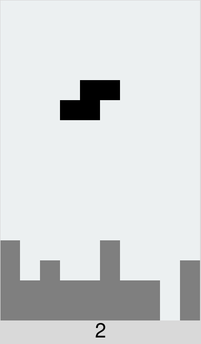w/up= rotate lefta/left= move lefts/down= move downd/right= move rightc= toggle color mode / monochromo modespace/escape= pause / resume / new game
The scoring is a simple as it can be. You get one point for every line cleared.
Monochrome mode (toggled with the c key) shows the falling piece as black
and frozen blocks as gray. This makes it easier to see the total shape
of the block landscape.
I've come up with some interesting ideas and techniques that I'd like to share below.
I found a very compact way to represent the piece shapes:
shapes = {
'O': ['56a9', '6a95', 'a956', '956a'],
'I': ['4567', '26ae', 'ba98', 'd951'],
'J': ['0456', '2159', 'a654', '8951'],
'L': ['2654', 'a951', '8456', '0159'],
'T': ['1456', '6159', '9654', '4951'],
'Z': ['0156', '2659', 'a954', '8451'],
'S': ['1254', 'a651', '8956', '0459'],
}Each hex character corresponds to a square in this 4x4 box:
0 1 2 3
4 5 6 7
8 9 a b
c d e f
For example the first rotation of T is '1456' which draws this shape:
- 1 - -
4 5 6 -
- - - -
- - - -
while the second rotation '6159' draws this shape:
- 1 - -
- 5 6 -
- 9 - -
- - - -
You can get coordinates with something like:
>>> [divmod(int(char, 16), 4) for char in '1456']
[(0, 1), (1, 0), (1, 1), (1, 2)]Note that these are returned in (y, x) order due to the use of divmod(). You may want to flip them around to (x, y) before using them.
The falling piece is represented as a dataclass:
@dataclass(frozen=True)
class Piece:
shape: str
rot: int = 0
x: int = 0
y: int = 0>>> from tetris import *
>>> piece = Piece('T')
>>> piece
Piece(shape='T', rot=0, x=0, y=0)To move or rotate the piece I use dataclasses.replace():
>>> replace(piece, x=piece.x + 1)
Piece(shape='T', rot=0, x=1, y=0)
>>> replace(piece, rot=(piece.rot + 1) % 4)
Piece(shape='T', rot=1, x=0, y=0)This returns a copy of the piece that I can test against the board to see if it fits before I actually move it.
If you choose a random shape every time there will sometimes be very long stretches between each I piece. A common solution is to put all 7 shapes in a bag and draw random shapes out of the bag until it's empty, and then repeat.
I've implemented this as a generator:
>>> random_shapes = random_shape_bag()
>>> next(random_shapes)
'L'
>>> next(random_shapes)
'S'
>>> next(random_shapes)
'Z'The field is a list of lists of shapes, with empty squares as ''. Here's a smaller 8x8 version:
field = [
['J', '', 'T', 'T', 'T', 'L', 'L', 'L']
['O', 'O', '', 'T', '', 'L', 'O', 'O']
['O', 'O', 'I', 'I', 'I', 'I', 'O', 'O'] # Full row
['', '', '', 'O', 'O', '', '', '' ]
['', '', '', 'O', 'O', '', '', '' ]
['', '', '', '', '', '', '', '' ]
['', '', '', '', '', '', '', '' ]
['', '', '', '', '', '', '', '' ]
]A few things to note here:
-
The field looks upside down here. Row 0 is normally drawn at the bottom of the screen.
-
We can still see which shape has made up each block. Since each shape has a distinct color this makes it easy to support colors.
Since the field is a list we can simple filter out full rows:
field = [row for row in field if not all(row)]Rows above the full rows will automatically collapse:
[
['J', '', 'T', 'T', 'T', 'L', 'L', 'L']
['O', 'O', '', 'T', '', 'L', 'O', 'O']
['', '', '', 'O', 'O', '', '', '' ]
['', '', '', 'O', 'O', '', '', '' ]
['', '', '', '', '', '', '', '' ]
['', '', '', '', '', '', '', '' ]
['', '', '', '', '', '', '', '' ]
]We then need to pad the field with as many new rows as we removed:
while len(field) < height:
field.append([''] * width)The BlockDisplay is a subclass of the Tkinter canvas. It's works like a very chunky pixel display where you can set the color of each pixel individually:
display[x, y] = 'T'The display will look up the color of the T piece and use it to set the fill of the rectangle at (x, y). You can clear a block with:
display[x, y] = ''This makes it straight forward to draw the field:
for x in range(width):
for y in range(height):
display[x, y] = field[y][x]and the piece:
char = piece.shape.lower()
for x, y in get_piece_blocks(piece):
display[x, y] = char(The active piece is drawn in lowercase to a allow the rendered to use a different style for it.)
I will tinker with the code from time to time but I have no plans for additional features.
Ole Martin Bjørndalen https://github.com/olemb/tetris/

